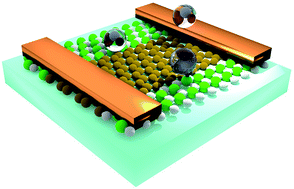Hybrid 2D nanodevices (graphene/h-BN): selecting NOx gas through the device interface
Abstract
Recent experiments demonstrated a highly controlled synthesis of in-plane graphene/hexagonal boron nitride heterostructures, thereby paving the way for the development of a new category of hybrid 2D nanodevices with different interfaces. Herein, by employing a combination of density functional theory (DFT) and the non-equilibrium Green's function formalism (NEGF), the gas sensor capability of G-hBN, containing two different interfaces is assessed by exposing it to NO, NO2, NH3, and CO2 gas molecules. Our results show that the strongest interaction occurs between NOx molecules and G-hBN; meanwhile, NO and NO2 molecules are more reactive in the interface regions than the pristine ones. In addition, the electron transport properties reveal that for a distinct two-port voltage applied, the gas molecule NO (NO2) can be detected by large changes in the conductance and CO2(NH3) has insignificant signal conductance, leading to selectivity for the gas. The proposed device is a great potential candidate to be applied as a NOx gas selector through a 2D nanodevice interface.



 Please wait while we load your content...
Please wait while we load your content...